With music running in the background, life is more elegant.
When people get involved with music or play instruments, they exude a different vibe, making them stand out.
Guitar is one of the most popular instruments that comes to mind when you refer to a "Musician."
It's not a coincidence that many people opt-in to learn the guitar. I mean, why not?
The knowledge of playing the guitar or any other musical instrument is an added weapon to your arsenal.
Learning the guitar has some profound benefits; it's not all fun and games.
"Musical training is a more potent instrument than any other because rhythm and harmony find their way into the inward places of the soul." - Plato
So, how about we give you a little insight on the matter?
You wouldn’t want to miss this. You might even consider taking online guitar lessons on it when we finish.
First, Know the Basics of Guitar
If you want to become a pro guitarist, mastering the basics should be your first and foremost goal.
Is a guitar that hard to master? - this is a question almost every beginner will ask.
Well, it’s no walk in the park, but it’s not rocket science either.
It would help if you learned about all the guitar parts to take full advantage of the instrument.

Or take Guitar courses online.
Wait, What are Guitar Chords?
It's just a fancy way of saying, “play several tones simultaneously.” That’s all there is to it.
There are tons of combinations you can learn.
The good news is, you don’t have to start with all of them.
Eight chords make up the basis for all beginner practices.
Take any one of your favorite songs; they use at least two or more, if not all these chords to make up their melodies.
So, learn the strings and get started with the chords.
8 Must Know Guitar Chords to Become a Pro Guitarist
Before we get started with chords, let’s see what fingers we use for each chord string.

Four out of five fingers are used regularly.
The thumb is also used in some rare cases to fret the string, but you won’t need it here.
Now, with that, let’s discuss the thing you’ve been patiently waiting to learn.
There’re 8 Chords that you should master: 6 Major Chords and 2 Minor Chords.
We'll see each of these with a chord diagram to help all beginner guitarists..

Major Guitar Chords
1. G major
When making a G major chord, you should ideally use your middle finger, ring finger, and pinky..
But in some cases, people also use the first three fingers - index, middle, and ring.
Your third finger, i.e., the ring finger, goes on the third fret of the low E string. Don't let your fingers brush any other line.
Place your middle finger, i.e., the second finger, on the second fret of the A string.
And finally, your fourth finger goes third fret of high string.
Strum all the six strings, and voila! You have the G Major.
Easy right?

2. C major
Let’s move on to the second chord - The C major.
Place your ring finger, i.e., the third finger on the third fret of the A string.
Keep your middle finger, i.e., the second finger on the second fret of the D string.
And your index finger, i.e., first finger on the first fret of the B string.
Make sure your fingers are coming right down on the strings.
It would help if you were on the tip of your fingers for the best results.
Leave the low E string and strum only the top when you strum.
There you have the C Major.

3. D major
Now let’s move on to the D major chord.
Place your first finger, i.e., your index finger, on the G string’s second fret.
Your third finger, i.e., ring finger goes on the third fret of the B string.
And your second finger, i.e., your middle finger, goes on the second fret of the high E string.
Now strum, but leave the low E and A out. Just strum the top four strings.

4. F major
This isn't very comforting because most people teach beginners as a barre chord.
But there is an easier version, so don’t worry.
The one we’ll talk about is only three notes.
Place your ring finger, i.e., the third finger, on the third fret of the D string.
Keep your middle finger, i.e., the second finger on the second fret of the G string].
And place your index finger, i.e., the first finger, on the first fret of the B string.
Now strum, but strum only these three strings.

5. E major
Place your middle finger, i.e., the second finger, on the second fret of the A string.
Place your ring finger, i.e., your third finger goes on the second fret of the D string.
And finally, keep your index finger i.e.your first finger, on the first fret of the G string.
Bear in mind to press through the tip of your fingers. Now strum all the six strings.

6. A Major
This is the last of the major chords we have now.
The A Major might prove a little challenging for beginners because you need to place your fingers in a tiny area of the second fret.
Put your index finger, i.e., the first finger, on the second fret of the D string.
Your middle finger, i.e., second finger on the second fret of the G string.
And your ring finger, i.e., third finger, on the B string’s second fret.
Strum just the top five strings and leave the low E string out.

Minor Chords
7. E minor
This is simply an E major chord with a bit of a change.
Just hold the E major chord on the guitar and take off your index finger or the first finger.
It’s as simple as that.

8. A minor
This is the last one we’ll talk about.
A minor is a special chord because it feels like holding an E major Chord but with a tiny change. Just move a string set.
Place your middle finger, i.e., the second finger, on the second fret of the D string.
Keep your ring finger, i.e., the third finger on the second fret of the G string.
And finally, your index finger, i.e., the first finger on the first fret of the B string.
Now strum the top 5 strings, leaving the low E string.
The chord shape seems just like the E major but with different strings.

8 Guitar Chords to Rule Them All
There are countless chord progressions people use to compose songs.
But many modern songs use just these 8 that we’ve discussed so far.
C - G - Am - F

This is the most popular chord setup in modern pop culture music.
These 4 chords are opposites and make an enjoyable progression.
G major opposes C major
A minor opposes G major, and
F major opposes A minor.
This contrast makes it sound elegant and soothing to the listener.
The list of songs that use this progression or combination starts with but is not limited to “Love Story” by Taylor Swift, “Hey soul sister” by Train, “Someone like you” by Adele, and many more.
Am - F - C - G

This combination of chords tends to sound saddened and darker sounds.
The songs that are on this list include “Cheap thrills” by Sia, “Numb” by Linkin Park, “Apologize” by OneRepublic.
You can find endless simpler or more intricate combinations that only use these 8 chords.
All it takes is practice.
There are songs that you can play with not more than 4 chords.
The possibilities are endless.
Conclusion
So, to summarize…
There are 8 must know guitar chords that you can use to compose or play any song.
Simple right?
If you commit to the process, you are sure to be a pro guitarist one day.
The longer you spend time understanding your instruments, the more you discover how to master them.
As you’ve reached this point, by now, you should have a pretty good idea of what you can do to be a pro.
Only acting on this desire will get you the result, so get going and strum those strings.
FAQs
1. How do I remember guitar chords?
Try to memorize the finger position and structure rather than looking at the fretboard.
Learn to make finger shapes
2. What’s the best way to practice guitar chords?
Choose a simple song or rhyme and try applying chords to the verses.
Start with the basic chords that have simple finger placements.
While doing this, pay attention to the shapes your fingers make and how they move along the fretboard.
3. What are different types of guitar chords?
The chords are classified into
Major
Minor
Also, with the level of complexity
7th chord
Diminished
Sus and augmented



Comments